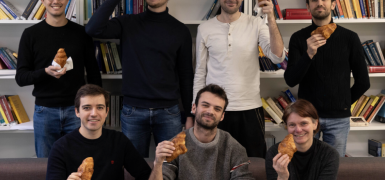86 billion neurons. 150,000 billion synapses. 180,000 kilometers of nerve fibers. And information circulating at over 400 kilometers/hour. The human brain is a prodigiously complex machine. Its exploration has only just begun. It represents one of the last great scientific frontiers.
In recent years, functional magnetic resonance imaging (fMRI) has enabled us to begin sketching an atlas of the different brain regions and the specific cognitive functions associated with these areas. These advances in acquisition systems are yielding a wealth of digital data. A wealth of information for the neurosciences. Even more so when different studies can be combined to produce what are known as meta-analyses. But there's a downside: it's still difficult to make sense of this often heterogeneous, noisy and uncertain data. And that's where NeuroLang comes in.
The project was born of an intuition by Demian Wassermann, a researcher in the MIND team at the Inria Center in Saclay. "What was missing was the ability to express hypotheses and ask questions of data in a way that was close to natural language. There's a gap between the hypothesis that we can put forward, i.e. the one that human beings formulate rhetorically, and a mathematical system that interrogates the data to find an answer to these questions."
From rhetorical question to mathematical formulation
In the background, a whole cultural change is taking place. "Until now, the history of human research has been based on this very rhetoric and on hypotheses formulated in human language. In contrast, quantitative methods are very new. The problem is that they require a much more formalized approach." From the human rhetorical question, NeuroLang automatically provides a mathematical formulation to better answer the question.
Given a question and the data, NeuroLang generates an algorithm which is in fact a mathematical formulation enabling the question to be answered in a reasonable time.
Demian Wassermann, Researcher in MIND project team
To help users express their questions, the new language is based on what is known as Controlled English. This is a subset of English that is less open to interpretation than natural rhetorical language, as it has clearer semantics. "Then, based on this question and the data, NeuroLang generates an algorithm which is in fact a mathematical formulation enabling the question to be answered in a reasonable time. Assuming the question has an answer, of course."
At the end of 2017, the project received a major boost when Demian Wassermann became the winner of a grant awarded by the European Research Council after a highly selective process. "The ERC likes risky ideas and provides a lot of funding". In this case: an envelope of €1.5 million. Enough to finance six years of work, at the end of which NeuroLang has reached a certain level of maturity. The research results have just been published in Scientific Reports, a journal of the Nature group. "The mathematical part took us a long time, but it works very well. We are now working intensively on the interface to make it easier to use."
NeuroLang used to study dyscalculia towards children
Among the first users are scientists from Stanford University, with whom Demian Wassermann has been collaborating for the past ten years. These researchers are interested in dyscalculia in certain children. They are studying the extent to which cognitive training can help. They want to know whether a relationship can be established between the structure of the child's brain and its sensitivity to cognitive training. The research suggests that if the child has more pronounced connections between certain brain areas, then the likelihood of regressing dyscalculia with cognitive training increases.
When a neurologist performs an analysis and asks a question using this new language, the answer produced is never yes or no. "For qualitative questions, we give a probability. To the question: is your reading ability better if your brain has such and such a particularity, we wouldn't answer true or false, but we'd say there's an 80% possibility that it's true." To assess this level of certainty, NeuroLang relies on artificial intelligence techniques that could be called "classical" and that have existed in computer science for a very long time.
On the other hand, when it comes to answering quantitative questions, researchers exploit more recent machine learning techniques. Also known as machine learning. "This quantitative analysis will indicate, for example, that certain cognitive faculties of a patient should drop by 30%. For this quantification, we use deep learning networks".
Helping the neurosurgeon with his operation
This second part is currently under development. It is the subject of a new project financed by the French National Research Agency (ANR) and carried out in partnership with the Assistance publique - Hôpitaux de Paris (AP-HP). More specifically, the neurosurgery unit at Hôpital Lariboisière.
The idea? "To help the surgeon choose the best route to access a tumor in the brain. The operation may damage an area. But the brain has a certain plasticity. It can relearn cognitive functions that will then relocate to other areas. That said, this plasticity is still a poorly understood phenomenon. Some functions seem to be more plastic than others, but we don't really know which ones, or in which areas. Using NeuroLang, we're trying to better understand this plasticity so that the surgeon can estimate, quantitatively, the patient's likelihood of regaining cognitive ability."
And the story isn't over yet. "There's still a lot of research to be done. In particular, to expand the number of questions that NeuroLang could answer."
Created in September 2023, MIND is a joint Inria project-team with CEA and Université Paris-Saclay. It is the partial successor to the former Parietal team. It comprises four permanent members: Bertrand Thirion, Demian Wassermann, Thomas Moreau et Philippe Ciuciu, who heads the team. A fifth permanent member, Chaithya Giliyar Radhakrishna, recruited through the CEA competition this summer, will join the team from November 2023.
His guiding principle: to use artificial intelligence methods on large databases to better understand how the brain works. "In neuroscience, as in other disciplines, a paradigm shift is underway. Instead of analyzing small datasets and trying to draw large conclusions from them, researchers are now striving to work on very large datasets to get a more precise idea of the phenomenology being studied", sums up Demian Wassermann.
MIND is one of four research units at NeuroSpin, which is both a department of the Institut des sciences du vivant Frédéric Joliot at the CEA Paris-Saclay research center, and a unique European platform of high-resolution nuclear magnetic resonance neuroimaging machines. "We benefit from the latest technologies for measuring brain data. To have at our disposal, in the same building, the full range of systems for measuring brain activity, both human and animal, is something extremely rare in the world. But it's not just a technology platform. NeuroSpin includes some of the world's leading cognitive science teams. So working here also enables us to have fluid exchanges with these very high-level teams."









